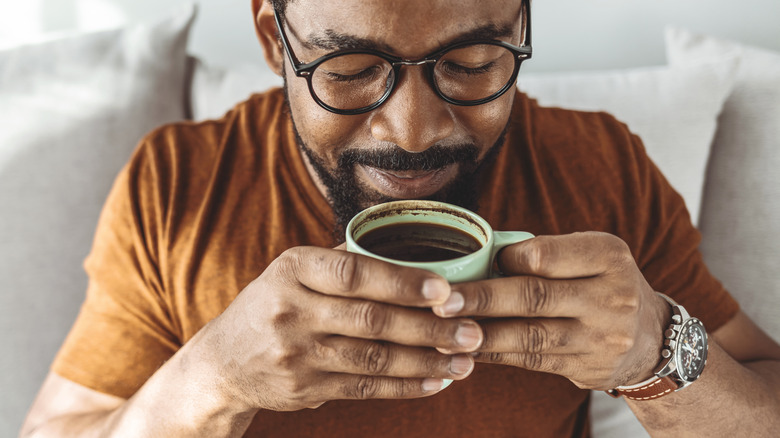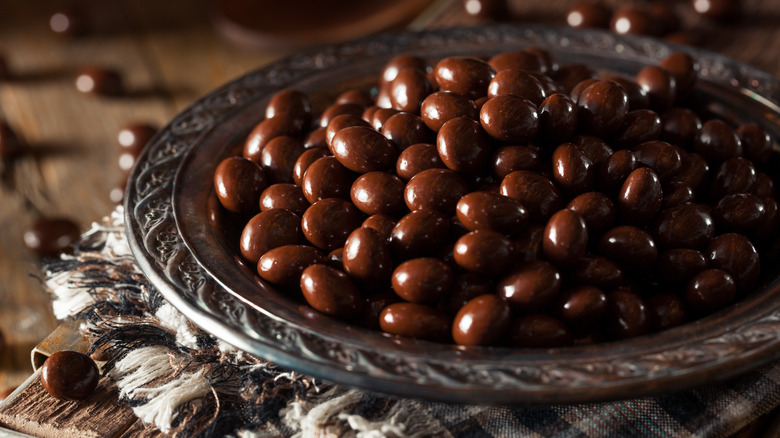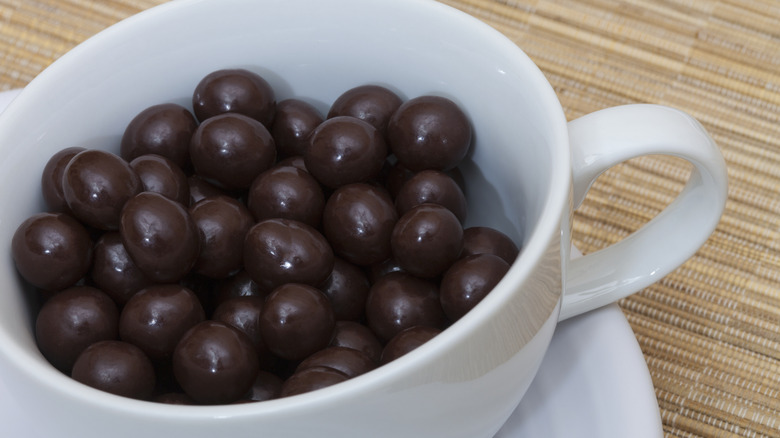How Many Chocolate Covered Espresso Beans Equal A Cup Of Coffee? (It's Fewer Than You Think)
If you're in the mood for a caffeinated treat but slurping down a hot, mid-afternoon cup of coffee sounds a little too heavy on your stomach, look no further than the delightful snack that is the chocolate-covered espresso bean. Whether you prefer your coffee beans wrapped in milk chocolate or dark chocolate, this small but mighty snack can give you just the lift you're looking for.
When eating a chocolate-covered coffee bean, you're actually eating the fruit of the coffee plant minus its hard outer shell, explains El Dorado Coffee Roasters. While these beans start off green and chewy, by the time they arrive on store shelves, they've been dried, softened, and roasted to their signature brown color. Coffee beans provide us with the same nutritious perks as a standard cup of coffee — hello, antioxidants! But much like you might add a little milk or sugar to your morning brew, adding chocolate to our espresso beans only sweetens the deal. But just how many chocolate-covered espresso beans does it take until we've had the equivalent of that cup of coffee? As it turns out, the answer can vary quite a bit.
Caffeine content can vary by type of chocolate
Let's take a look at a 3.5-ounce bag of Taza Perfectly Unrefined Chocolate Covered Espresso Beans made with 55% dark chocolate. In a 28-gram serving, which the company equates to approximately 36 beans, you'll find 135 milligrams of caffeine (via Taza). This boils down to 3.75 milligrams of caffeine per bean. In an 8-ounce cup of coffee, you'll find between 80 and 100 milligrams of caffeine, reports the U.S. Food and Drug Administration (FDA). If we were to stick with 100 milligrams as a nice round number, that means a person would need to eat about 26.5 chocolate-covered espresso beans to get approximately the same amount of caffeine as a cup of coffee.
Now, granted, that's quite a few coffee beans. However, Taza chocolate-covered espresso beans appear to be on the lower end of the caffeine spectrum, seeing as Caffeine Informer reports that milk chocolate-covered espresso beans can contain anywhere from 5 to 10 milligrams of caffeine each, while dark chocolate-covered espresso beans can harbor between 6 and 11 milligrams. El Dorado Coffee Roasters places this number even higher, saying that dark chocolate-covered espresso beans can have as much as 12 milligrams of caffeine per bean.
Don't exceed this many chocolate-covered espresso beans in a day
Breaking this down even further, that means a person would need to eat 20 chocolate-covered espresso beans (if they had a caffeine content of 5 milligrams each) to match the 100 milligrams of caffeine in a cup of coffee. For beans containing 10 milligrams of caffeine each, a person would only need to eat ten. At the highest end of the spectrum, if you were to snack on some chocolate-covered espresso beans containing 12 milligrams of caffeine each, you would only need to eat a little over eight beans before you'd consumed the caffeine equivalent of a cup of coffee. That's certainly fewer than you might think. As previously mentioned, higher caffeine concentrations are usually found in espresso beans covered in dark chocolate rather than milk chocolate.
The FDA states that most healthy adults can consume up to 400 milligrams of caffeine daily without risk of adverse side effects. Excess coffee consumption can lead to headache, nausea, accelerated heart rate, anxiety, insomnia, and more, particularly in those who may be caffeine sensitive. El Dorado Coffee Roasters notes that a person would need to consume around 30 chocolate-covered espresso beans, each containing 12 milligrams of caffeine, to stay safely below 400 milligrams. Eating 34 beans, however, would place you over this limit. Although 34 beans may sound like a lot, it's easy to lose track of how many beans we've eaten when they're as delicious as they are. Therefore, chocolate-covered espresso beans are best consumed in mindful moderation.



